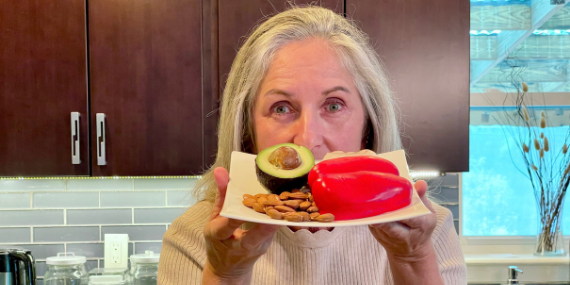“Watch what you eat” is a standard recommendation from family, friends, and some nutrition experts when you want to lose weight. Or you may have been told to watch your waistline. This comment puts the focus on going on a diet. Reducing calories, losing weight, slimming down, starving, or slenderizing are synonyms for watching what you eat. But watching what you eat doesn’t only have to be about losing weight, and has so many benefits, especially for women over 50. There are four easy ways to improve your diet and eat healthily that you can start doing too.
How Our Diet Impacts Our Health
The average American diet is full of unhealthy foods, such as processed foods, saturated fats, and refined carbohydrates. In addition, according to the Centers for Disease Control, an increasingly sedentary lifestyle has led to over one-third of the US adult population being obese.

Lower Risk Factors of Diseases
A healthy diet may help prevent certain serious diseases such as heart disease, stroke, and type 2 diabetes. It may also help to reduce your risk of developing some cancers. In addition, if you become sick, eating a healthy diet may help you recover more quickly.

Boosts Energy Levels
Including whole foods or other nutrient-dense foods in your diet will boost your energy levels. However, energy-dense foods contain a higher number of calories per serving. In contrast, nutrient-dense whole foods have higher vitamins, minerals, and other essential nutrients with little or no added sugars, unhealthy fats, and high calories.
Consuming large amounts of processed foods loaded with unhealthy fats and sugars will lead to carbohydrate or sugar crashes. Instead, exchange them for foods high in healthy fats and fiber. You’ll feel better and can avoid the afternoon slumps.

Improve Your Diet And Look and Feel Better
Have you ever looked at another woman and wondered: “How does she do it?” Her skin is glowing; her hair is shiny; she is in great shape, full of energy, and has a spring in her step.
What you eat and drink greatly affects how you look and feel. Eating balanced meals high in lean protein, healthy fats, and non-processed carbohydrates fuels your body’s energy and stabilizes your blood sugar levels; therefore, you have fewer cravings. Remember that sugary drinks will spike your sugar cravings and lead to unwanted weight gain. For example, a glass of wine, which is a sugary drink, will often lead to snacking or drinking more wine.

There are several ways to watch what you eat.
Some experts tell you to count calories or log every macronutrient. Then some want you to listen to your body. This can be confusing because everyone has something they promise will help you reach your goal of “watching what you eat.” If you’re interested in my take on several popular diets, check out my blog post: Dissecting Diets – Which One Is Right For You?
But guess what?
Calorie counting, measuring macros, and hand portioning all work, as will mindful eating and intuitive eating, but there are essential facts to consider.
First, ask yourself what problem food monitoring helps ME solve. Yes, the emphasis is on YOU and your problem because that changes your strategy.
The following are possible goals you might be pursuing.
You might want to:
- Lose weight and get healthier
- Understand your eating habits better
- Feel better in your jeans
- Develop a better relationship with food
- Lose a specific body fat percentage
But over time, the effectiveness of your chosen watch-what-you-eat method will likely diminish. So, in the end, you do what works best for your lifestyle and mix and match what works for your needs. Remember, your goals change over time.

Your approach needs to have several important components to work and be sustainable:
- It has to be practical and doable.
- It needs to align with your current goals.
- It fits into your daily routine.
Implement Mindful Eating Strategies
Mindful or intuitive eating is very similar, and you can read or listen to more about it in my blog post: 5 Ways To Practice Mindful Eating.
Mindful eating is the practice of eating mindfully and being present while eating. That means you evaluate your reasons for hunger. We teach this approach in detail in the Pursue Your Spark Blueprint.
Knowing why you eat, how full you are, and your relationship with food results in better health and frequent weight loss.

How do you start to watch what you eat?
- Decide on your goal. Example: I want to eat more vegetables.
- Make a list of vegetables you love. This trick will help when you are stumped at the store on what to buy.
- Find some easy recipes. But if you don’t like to cook, then cutting up vegetables and making a salad will do the trick. For more ideas, go to my post: 5 Easy Meal Prep Tips That Any Beginner Can Do.
- Choose which watch-what-you-eat method you would like to start with.
- Start logging how many vegetables you eat every day. You can write them down or even use an app or your smartphone notes to log your progress.

How can you track what you eat?
If you like to track more than just how many vegetables you eat, there are two popular apps that are easy to use, like MyFitnessPal (track calories, macros, and workouts); we use this app in the Pursue Your Spark Blueprint and LoseIt is another simple choice. Both MyFitnessPal and LoseIt have free versions too.
It’s tempting not to track your progress, but if you want to see results, you have to know what you’re doing and if that approach works.

4 Easy Ways To Improve Your Diet and Eat Healthily
- Make small changes over time
Building healthy habits takes time. Pick one goal you want to reach and keep working towards. You need to practice this habit repeatedly to achieve your goal. Choose long-term success over the quick fix that doesn’t last.
2. Eat what you like
It seems as if everyone loves kale and its superpowers, but if you can’t stand it, then choose what you love. Forcing yourself to eat what you don’t like is a recipe for failure.

3. Fit your meals around your schedule
Some people like 6 small meals. Others prefer 3 – 4 meals, which works for their lifestyle. Others practice Intermittent Fasting and follow a 12 – 16 hour fast, which results in 2 – 3 meals per day. Intermittent Fasting simplifies mealtime by cutting down on the meals you must prepare. For more information on how to get started, check out the Pursue Your Spark Blueprint.
4. You can eat anything you want but…
There is nothing wrong with the occasional ice cream or muffin, but remember why you’re eating this treat and what it satisfies. If you have cravings more often, then it’s time to look at your overall nutrition intake and the deficiencies you might have.
Suppose you feel like you want a sugary treat or a salty bag of chips. Go for it! Don’t feel guilty and ashamed. Once satisfied, go back to the healthy habit.

It is essential to “Watch What You Eat” to reach your health and nutrition goals. It is easy to get distracted by shiny new diet approaches that promise results. Instead, stick to a nutrition strategy that fits your lifestyle, is easily implemented, helps you change habits, and is sustainable.
Heike, these are such great reminders for me. I’ve taken a turn from healthy eating and this is a good reminder to get back on track, so I truly thank you for helping me to do better-for my own health!
Michele, I’m so happy that my tips resonated with you.
4 great tips! The first one definitely works for me, as I find that making small gradual changes works better than cleanses or restrictive diets. I’ve also learned that when I have cravings, it’s usually because I’m tired, so lately I’ve been tying to focus on sleep rather than powering through the day with sugar. xo Nipa
Comments are closed.